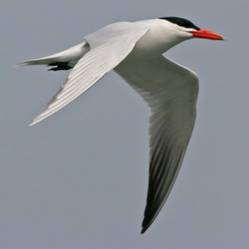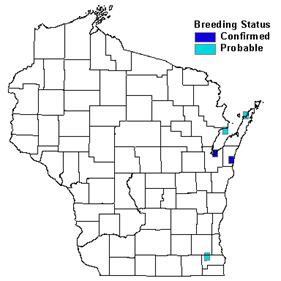Photo by Scott Franke


Status/Protection
- Global Rank: G5 Key to global and state ranks
- State Rank: S1B, S2N
- WBCI Priority: SGCN, State Endangered
Population Information
The Federal BBS information can be obtained at http://www.mbr-pwrc.usgs.gov/bbs/bbs.html by clicking on Trend Estimates and selecting the species in question. All estimates are for time period (1966-2005).
- Federal Breeding Bird Survey: non-significant increase
- Federal Breeding Bird Survey (WI): N/A
- Federal Breeding Bird Survey (BCR 23): N/A
- Federal Breeding Bird Survey (BCR 12): N/A
- WSO Checklist Project: significant increase (1983-2007)
Life History
- Breeding Range: Scattered localities across North America; worldwide distribution (Cuthbert and Wires 1999).
- Breeding Habitat: Great Lakes Beach and Dune; isolated islands and shorelines.
- Nest: Ground scrape in sparsely vegetated area.
- Nesting Dates: Late May to early July (Robbins 1991).
- Foraging: High dives (Ehrlich et al. 1988).
- Migrant Status: Short-distance migrant, Neotropical migrant.
- Habitat use during Migration: Great Lakes Open Water, Great Lakes Beach and Dune; large rivers and inland freshwater lakes (Cuthbert and Wires 1999).
- Arrival Dates: Mid-April to early June (Robbins 1991).
- Departure Dates: Mid-July to mid-October (Robbins 1991).
- Winter Range: Pacific Coast to Central America and Atlantic Coast to Gulf Coast of southern Mexico.
- Winter Habitat: Coastlines, large rivers, and large inland freshwater lakes.
Habitat Selection
The Caspian Tern nests on freshwater and coastal islands, beaches, and shorelines isolated from human disturbance (Cuthbert and Wires 1999, Strong et al 2004, Matteson 2006). Nest sites generally have little to no vegetation, sometimes resulting from thick layers of fecal deposits surrounding nests (Scharf 1963), and include a variety of flat nest substrates, such as cobble-gravel, crushed stone, sand, dredge spoil, (Scharf 1979, Cuthbert and Wires 1999, Matteson 2006) and occasionally artificial nesting platforms (Lampman et al. 1996). Nest sites are susceptible to flooding and thus nests often are located at the highest point of an island or shoreline, usually elevated 2-3 m above water level (Cuthbert and Wires 1999). The nest is a scrape, often lined with dried vegetation, sticks, small pebbles, bits of broken clam shells, feathers, or debris (Bent 1963).
The Caspian Tern generally nests in colonies ranging from several to hundreds of pairs, but a pair may nest singly near the nests of other tern or gull species (Cuthbert and Wires 1999). Erosion, drought, flooding, and vegetation encroachment can alter the suitability of colony sites from year to year and lessen site fidelity (Suryan et al. 2004). However, if conditions remain suitable, terns often return to colonies where they successfully raised young (Cuthbert 1988).
Habitat Availability
The Caspian Tern is a fairly common migrant in Wisconsin (Robbins 1991) but has never been a common breeder in Wisconsin or the Great Lakes region (Hyde 1996). Historically, the Caspian Tern nested irregularly in northeastern Wisconsin, primarily on isolated islands within Green Bay and Door County (Kumlien and Hollister 1903, Ward 1906). Recently, this species occupied a colony site near the Milwaukee U.S. Coast Guard Impoundment in southeastern Wisconsin (Matteson 2003) and continues to intermittently nest along the Lake Michigan coast in northeastern Wisconsin (Matteson 2006). Breeding habitat used by this species often is unstable and subject to flooding, erosion, vegetative encroachment, and other natural and anthropogenic disturbances. Furthermore, prey availability and the presence of nest predators also influence the establishment of colony sites (Suryan et al. 2004). Given these unpredictable conditions, the availability of suitable nesting habitat fluctuates from year to year. Fortunately, the Caspian Tern is able to respond quickly to habitat changes and rapidly colonize new areas (Wires and Cuthbert 2000).
Population Concerns
In North America, concerns for declining numbers or limited habitat led many states and provinces to designate Caspian Terns as a protected species (Wires and Cuthbert 2000). The Caspian Tern was officially listed as a Wisconsin endangered species in 1989 (Matteson 2003). Over the last three decades, populations have started to recover, particularly on Lake Ontario and along the Pacific coast where the largest colony in North America (>10,000 pairs) resides (Cuthbert and Wires 1999). Breeding Bird Survey (BBS) data indicate a non-significant population increase range-wide (Sauer et al. 2005), although BBS may not be the most reliable survey method due to this species’ semicolonial nesting habits and localized distribution. Since the late 1960s, the Great Lakes population has nearly tripled, mostly driven by dramatic annual increases on Lake Ontario (Wires and Cuthbert 2000). Matteson (1993) presented a recovery goal of at least 100 nesting pairs over a 10-year period and an average annual production of at least 100 young for at least 5 years of a 10-year period. The Caspian Tern is inadequately sampled by BBS in Wisconsin but Wisconsin Checklist Project data indicate a significant increase from 1983-2005 (Rolley 2005). It is no longer a rare nesting species here, although only two breeding colonies were documented during the Wisconsin Breeding Bird Atlas (1995-2000). In 2006, however, four colonies in southeastern, east-central, and northeastern Wisconsin contained a total of 1,338 nests (Matteson 2006). The primary factors limiting populations appears to be the availability of nest sites free from human and predator disturbance (Cuthbert and Wires 1999).
Recommended Management
Partnerships between state and federal agencies and private organizations dedicated to the restoration, conservation, and management of Great Lakes coastal ecosystems will benefit the long-term management of both Caspian and Common Terns (WDNR 2005). The conservation and management of dredge spoil sites and other island sites as Caspian Tern nesting colonies also is recommended (WDNR 2005). Managers should control vegetative growth and minimize disturbance in areas designated for Caspian Tern conservation. Wherever applicable, managers should maintain water levels at a depth that will prevent land-bridging (i.e., allowing access to mammalian predators and human disturbance) and flooding during the breeding season (Strong et al. 2004). Also, regulations that eliminate or limit the presence of organochlorine contaminants are recommended (WDNR 2005).
Research Needs
Targeted surveys are needed to better monitor trends for populations of Caspian Terns in Wisconsin and across their breeding range. The impacts of interspecific competition, particularly with Ring-billed Gulls and Herring Gulls, needs more study at Great Lakes colony sites. Researchers should continue to monitor and assess the effects of chemical contamination on Caspian Tern reproduction and survival (Cuthbert and Wires 1999).
Information Sources
- Cornell Lab of Ornithology species account: http://www.birds.cornell.edu/AllAboutBirds/BirdGuide/Caspian_Tern.html
- Environment Canada species account: http://www.qc.ec.gc.ca/faune/oiseaux_menaces/html/sterne_caspienne_e.html
- North American Breeding Bird Survey http://www.mbr-pwrc.usgs.gov/bbs/bbs.html
- Wisconsin Breeding Bird Atlas: http://www.uwgb.edu/birds/wbba/
- Wisconsin Department of Natural Resources fact sheet: http://www.dnr.state.wi.us/org/land/er/factsheets/birds/Caster.htm
References
- Bent, A.C. 1963. Life histories of North America gulls and tern. Dover Publications, Inc. New York.
- Cuthbert, F.J. 1985. Intraseasonal movement between colony sites by Caspian Terns in the Great Lakes. Wilson Bulletin 97:502-510.
- Cuthbert, F.J. 1988. Reproductive success and colony-site tenacity in Caspian Terns. Auk 105:339-344.
- Cuthbert, F.J. and L.R. Wires. 1999. Caspian Tern (Sterna caspian). In A. Poole and F. Gill, eds. The birds of North America, No. 403. The Academy of Natural Sciences, Philadelphia, and the American Ornithologists’ Union, Washington D.C.
- Ehrlich, P.R., D.S. Dobkin, and D. Wheye. 1988. The birders handbook: a field guide to the natural history of North American birds. Simon & Schuster, Inc. New York.
- Lampman, K. P., M.E. Taylor, and H. Blokpoel. 1996. Caspian Terns (Sterna caspia) breed successfully on a nesting raft. Colonial Waterbirds 19:135-138.
- Matteson, S.W. 1993. Wisconsin Caspian Tern Recovery Plan. Wisconsin Endangered Resources Report. Bureau of Endangered Resources, Wisconsin Department of Natural Resources, Madison. 28 pp.
- Matteson, S.W. 2006. Caspian Tern. In Atlas of the Breeding Birds of Wisconsin (N.J. Cutright, B.R Harriman, and R.W Howe, eds.). Wisconsin Society of Ornithology, Inc. 602pp.
- Matteson, S.W. 2003. Conservation of endangered, threatened and nongame bird. Performance Report, July 2002-30 June 2003. Wisconsin Department of Natural Resources, Madison. 35pp.
- Robbins, S.D. 1991. Wisconsin birdlife: population & distribution, past & present. Univ of Wisconsin Press, Madison, WI.
- Rolley, R. 2005. Wisconsin Checklist Project. http://dnr.wi.gov/org/land/wildlife/harvest/reports/07checklist.pdf (6 April 2007)
- Sauer, J.R., J.E. Hines, and J. Fallon. 2005. The North American Breeding Bird Survey, Results and Analysis 1966 - 2005. Version 6.2.2006. USGS Patuxent Wildlife Research Center, Laurel, MD.
- Scharf, W.C. 1979. Nesting and migration areas of birds of the U.S. Great Lakes (30 April to 25 August 1976). U.S. Fish and Wildlife Service, Office of Biological Services. FWS/OBS-77/2. 113 pp.
- Strong, C.M., L.B. Spear, T.P. Ryan, and R.E. Dakin. 2004. Forster's tern, Caspian tern, and California gull colonies in San Francisco Bay: habitat use, numbers and trends, 1982-2003. Waterbirds 27(4): 411-423.
- Suryan, R.M., D.P. Craig, D.D. Roby, N.D. Chelgren, K. Collis, D.W. Shuford, and D.E. Lyons. 2004. Redistribution and growth of the Caspian tern population in the Pacific Coast region of North America, 1981-2000. Condor 106(4): 777-790.
- Ward, H.L. 1906. Notes on the Herring Gull and the Caspian Tern. Bulletin of the Wisconsin Natural History Society 4: 113-120.
- Wires, L.R. and F.J. Cuthbert. 2000. Trends in Caspian Tern numbers and distribution in North America: a review. Waterbirds 23(3): 388-404.
- Wisconsin Department of Natural Resources (WDNR). 2005. Wisconsin’s Strategy for Wildlife Species of Greatest Conservation Need. Madison, WI.
Contact Information
- Compiler: Dan Haskell, danhaskell@hotmail.com
- Editor: Kim Kreitinger, K.Kreitinger@gmail.com
